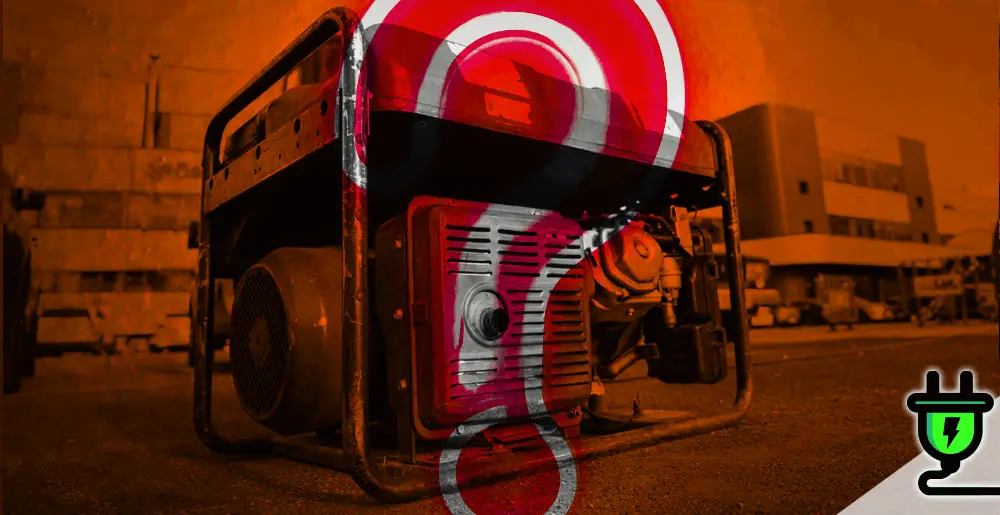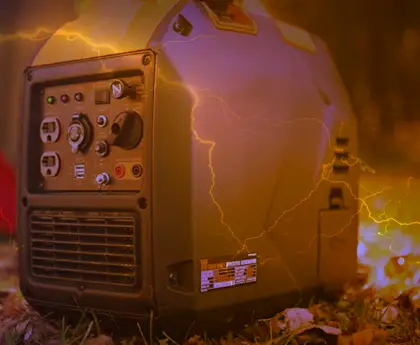Experiencing a power outage can be immensely frustrating. Did you know that a portable home generator could provide an effective solution to this issue? But, how does a portable home generator work?
Electricity is generated by a portable generator through the operation of a gas or propane powered engine, which drives an on-board alternator. These units come equipped with power outlets, enabling you to connect extension cords, electric-powered tools, and appliances into it.
This article will demystify how these handy devices convert fuel into electricity, keeping your lights on when the grid fails.
Let’s illuminate the workings of portable generators together!
How Does a Portable Home Generator Work?
A portable home generator works by converting mechanical energy into electrical energy using a gas engine as the power source and an onboard alternator to generate electricity.
Conversion of mechanical energy into electrical energy
Portable generators harness the power of gasoline, propane, or diesel to produce mechanical energy. This fuel ignites within the engine, triggering a series of reactions that move pistons and crankshafts.
As these components shift and turn inside the generator’s motor unit, they generate significant amounts of mechanical energy. The alternator comes into play next; it converts this mechanical energy into electrical power through electromagnetic induction.
Transformers inside the alternating component adjust voltage levels to meet your home’s specific needs – powering everything from light bulbs to kitchen appliances in times of power outages.
Gas engine as the power source
A portable home generator operates by utilizing a gas engine as its power source. The gas engine is responsible for generating the mechanical energy needed to produce electricity. This energy is then converted into electrical energy through electromagnetic induction, enabling the generator to supply power to your home.
Various types of fuel, such as gasoline, propane, or diesel, can be used to operate the gas engine and facilitate the conversion process. With this reliable power source, you can ensure that your essential appliances and devices remain functional during power outages or emergencies without any interruptions.
Onboard alternator to generate electricity
The portable home generator uses an onboard alternator to generate electricity. This alternator is responsible for converting mechanical energy into electrical energy, which can then be used to power various devices and appliances in your home.
By relying on this alternator, the generator can efficiently produce the electricity you need during a power outage or in other emergency situations. It’s a crucial component that allows the generator to provide the necessary power backup for your home.
Parts of a Portable Generator
A portable generator consists of several key parts, including the engine, fuel tank, alternator, voltage regulator, and control panel.
Engine
The engine is a crucial component of a portable generator. It uses gasoline, propane, or diesel as fuel to create the mechanical energy required for electricity generation. When the fuel is ignited in the internal combustion engine, it produces power that drives the alternator and generates electricity.
The size and power output of the engine determine how much electrical energy the generator can produce. Portable generators have different engine types and sizes to meet various power needs.
They are designed to be compact and efficient, making them an essential tool for providing emergency backup power during outages or when there is no access to electricity.
Fuel tank
The fuel tank is an essential part of a portable generator. It stores the gasoline, propane, or diesel that fuels the generator engine. The capacity of the fuel tank can vary depending on the size and model of the generator.
A larger fuel tank allows for longer run times without needing to refuel. When using a portable generator, it’s important to monitor the fuel level and ensure there is enough fuel to power your devices or home during an outage.
Regular maintenance, such as keeping the fuel tank clean and free from debris, is necessary to keep your generator running smoothly.
Alternator
The alternator is a crucial part of a portable generator. It is responsible for converting mechanical energy into electrical energy. When the gas engine powers the generator, it rotates the alternator, which then produces an electromagnetic field that induces electricity.
This electricity is used to power various devices in a home or during emergencies. The alternator plays a key role in ensuring that the generator can provide reliable and consistent electrical power whenever it is needed.
Voltage regulator
The voltage regulator is an essential part of a portable generator. It ensures that the electrical output remains stable and consistent, even when there are fluctuations in power demand or variations in the motor’s speed.
The voltage regulator controls the flow of electricity to prevent damage to sensitive electronics and appliances. By regulating the voltage, it helps maintain a steady supply of power for all your needs, ensuring that your devices operate safely and efficiently.
Control panel
The control panel of a portable generator is where you can find all the important controls and indicators. It allows you to start and stop the generator, monitor fuel levels, and check voltage output.
The control panel typically includes buttons or switches for power on/off, engine start/stop, and fuel shut-off. Additionally, there are gauges or digital displays that show vital information such as voltage output and running time.
Some advanced models may even have features like electric-start buttons or remote control options for added convenience. With the control panel, it becomes easy to operate and monitor your portable generator efficiently without any complicated procedures.
Safety Considerations for Using a Portable Generator
Ensure carbon monoxide safety by never operating the generator indoors or in enclosed spaces.
Carbon monoxide safety
Carbon monoxide safety is crucial when using a portable generator. Carbon monoxide is a colorless, odorless gas that can be produced by the generator’s engine. It can be extremely dangerous and even deadly if inhaled in high concentrations.
To ensure safety, it is important to always operate a portable generator outdoors in a well-ventilated area. Never use a generator inside your home, garage, or any enclosed space where carbon monoxide can accumulate.
Installing carbon monoxide detectors in your home is also recommended to provide an extra layer of protection against this silent killer.
Fuel quality and safety
Ensuring fuel quality and safety is crucial when using a portable generator. Using clean, high-quality fuel helps maintain the efficiency of the generator’s engine and ensures reliable power production.
It is recommended to use fresh gasoline, propane, or diesel that meets the manufacturer’s specifications. Storing fuel in approved containers away from ignition sources is important for safety purposes.
Regularly inspecting the fuel tank for leaks or damage can prevent accidents and ensure proper functioning of the generator. Proper ventilation is also essential to prevent carbon monoxide build-up when operating a portable generator indoors or in enclosed spaces.
Weather safety
Extreme weather conditions can pose risks when using a portable generator. In heavy rain or snow, it is crucial to keep the generator protected from moisture and ensure it is positioned on a flat surface.
This prevents electrical shock and damage to the generator. Additionally, high winds can blow over generators if they are not properly anchored or secured. It’s essential to follow safety guidelines and keep the generator away from windows, doors, or vents to prevent dangerous fumes from entering the living area during use.
Operational safety
Operational safety is crucial when using a portable generator. Always follow the manufacturer’s instructions to ensure safe operation. Before starting the generator, make sure it is placed in a well-ventilated area outside your home to prevent carbon monoxide buildup.
Keep flammable materials away from the generator and never refuel while it is running. Regularly inspect the generator for any signs of wear or damage and maintain it properly to avoid accidents.
By prioritizing operational safety, you can enjoy the benefits of a portable generator without compromising your well-being or that of others around you.
Benefits of Using a Portable Home Generator
A portable home generator provides power backup during outages, offers portability for various applications, and has versatility in powering different devices.
Power backup during outages
A portable home generator provides a reliable power backup during outages. When there’s an interruption in the main power supply, the generator kicks in to provide electricity for essential devices and appliances in your home.
It ensures that you can keep your lights on, refrigerators running, and important electronics powered up. With a portable generator, you won’t have to worry about being left in the dark or losing perishable foods during unexpected power outages.
Whether it’s due to severe weather conditions or maintenance work on the electrical grid, having a portable home generator gives you peace of mind knowing that you’ll still have access to electricity when you need it most.
Portability for various applications
Portable generators offer the convenience of easy mobility, making them suitable for a wide range of applications. Whether you’re camping in the great outdoors, hosting an outdoor event, or working on a construction site, a portable generator can provide the power you need wherever you go.
With their compact design and lightweight construction, these generators can be transported easily from one location to another without hassle. This portability factor allows users to bring power wherever it’s needed most, ensuring that electrical devices and appliances can function efficiently no matter the setting or situation.
Versatility in powering different devices
A portable home generator offers versatility when it comes to powering different devices. Whether it’s during a power outage, camping trip, or outdoor event, this type of generator can provide the necessary electrical power for various applications.
With its ability to generate electricity on the go, you can easily plug in and power up essential appliances like refrigerators, lights, fans, and even electronic devices such as phones and laptops.
This versatility makes a portable home generator a reliable and convenient solution for your power needs in various situations.
How Does A Portable Home Generator Work FAQs
How does a portable home generator work?
A portable home generator works by converting mechanical energy into electrical energy. It uses an internal combustion engine to spin a rotor that generates electricity through electromagnetic induction.
What fuel do portable home generators use?
Portable home generators typically use gasoline, propane, or diesel as their fuel source. The chosen fuel is stored in a tank and fed to the engine for combustion.
Can I power my entire house with a portable home generator?
The capacity of a portable home generator determines how much power it can provide. While some larger models may be able to power multiple appliances simultaneously, most portable generators are designed to provide temporary backup power for essential items like refrigerators, lights, and small electronics.
How do I connect my appliances to a portable home generator?
To connect your appliances to a portable home generator, you will need to use extension cords or transfer switches. Extension cords allow you to directly plug devices into the generator’s outlets, while transfer switches enable you to connect the generator directly to your house’s electrical panel for powering specific circuits during an outage.
Conclusion
In conclusion, a portable home generator works by using a gas engine to convert mechanical energy into electrical energy. It has various parts such as the engine, fuel tank, alternator, voltage regulator, and control panel that work together to generate power during outages or in remote locations.
With its versatility and portability, a portable generator provides an essential backup power source for homes and offers peace of mind during emergencies.






